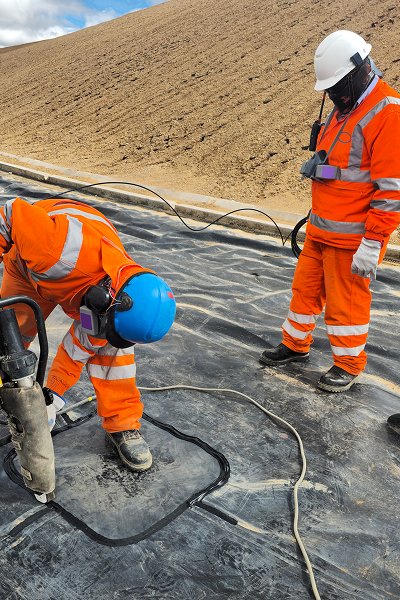What is polyester geogrid?
Polyester geogrid is a geosynthetic material made of high-strength polyester filaments woven into a mesh structure and treated with PVC coating. It is mainly used to strengthen the soil structure, improve its overall stability and bearing capacity, and has been widely used in infrastructure construction, road engineering, railways, bridges, slope reinforcement and other fields.

Key Technical Properties
| Property | Range / Value |
|---|---|
| Tensile Strength (kN/m) | 20 – 400 (depending on model) |
| Elongation at Break (%) | ≤ 10 |
| Mesh Size (mm) | 25×25, 40×40, customizable |
| Chemical Resistance | Excellent (resistant to acids and alkalis) |
| Working Temperature (°C) | -30 to +80 |
| Density (g/cm³) | 1.3 – 1.4 |
| Coating Type | PVC / PE / Bitumen |
Typical Product Specifications
| Model | Tensile Strength (kN/m) | Elongation (%) | Mesh Size (mm) |
|---|---|---|---|
| PET30-30 | 30 / 30 | ≤ 10 | 40 × 40 |
| PET50-50 | 50 / 50 | ≤ 10 | 25 × 25 |
| PET100-100 | 100 / 100 | ≤ 8 | 40 × 40 |
| PET200-200 | 200 / 200 | ≤ 6 | 40 × 40 |
Advantages of Polyester Geogrid
High tensile strength and low elongation
One of the core properties of polyester geogrid is its excellent tensile strength. The tensile strength of conventional products in the warp and weft directions can reach 20~400kN/m, which is suitable for engineering needs of various strength levels.
Advantages:
It can effectively resist lateral deformation of soil and crack expansion;
It performs stably in scenes with frequent dynamic loads such as roads and railways;
The elongation is generally controlled at ≤10%, with small deformation and strong structural retention.
Excellent corrosion resistance
Polyester material itself has good chemical stability and can resist most acid, alkali, salt and microbial corrosion. After the surface is coated with PVC, PE or asphalt, its durability is further enhanced.
Applicable to:
Landfills, sewage treatment plants, saline-alkali land and other highly corrosive environments;
Medium- and long-term engineering use in different climate zones.
Stable structure and strong bite
Polyester grid adopts warp knitting structure, with uniform and regular mesh size, and has good "bite" ability with soil. After laying, it can quickly form a composite reinforced structure, effectively improving the bearing capacity and shear resistance of the foundation.
Technical advantages:
Reduce roadbed settlement;
Improve the stability of soft soil foundation;
Reduce maintenance frequency and extend service life.
Good flexibility and strong adaptability
Polyester geogrid is soft, light, easy to transport and lay, and can adapt to different terrain changes. It is particularly suitable for construction scenes with complex landforms and special-shaped structures.
Compared with traditional rigid materials:
Polyester grid can be laid on irregular locations such as undulating ground, slopes, corners, etc.;
Construction does not require large equipment and can be quickly deployed manually, greatly reducing labor and time costs.
Application fields of polyester geogrid
Road and railway subgrade reinforcement
Polyester geogrids can significantly enhance the stability of soft foundations, improve the bearing capacity of roadbeds, reduce settlement and cracking, and extend the life of the road surface.
Applicable scenarios:
Reinforcement of base and subbase of high-grade highways and heavy-load railways;
Special soft soil areas such as permafrost, collapsible loess, silt, etc.;
High fill or areas with uneven bearing capacity of underlying base.

Slope protection and reinforcement projects
In high slopes, steep slopes or landslide-prone areas, polyester grids can be combined with shotcrete, plant slope protection, soil nail walls, etc. to form an overall anti-slip stable structure.
Applicable projects:
Slopes on both sides of highways;
Slope reinforcement of mountain railways;
Anti-scouring stabilization projects of soil-rock mixed slopes.

Water conservancy projects and dam reinforcement
Polyester grid is used as auxiliary stabilizing material in channel slope protection, dam reinforcement, and energy dissipation structure to improve overall safety.
Typical uses:
Channel bottom protection and anti-scouring;
Reinforcement of spillway or culvert slopes;
Reinforcement of the water-facing surface of flood control embankments.

Polyester geogrid has high tensile strength, low elongation, excellent corrosion resistance and anti-aging ability, and can operate stably for a long time in various complex and harsh environments. From the perspective of applicable scenarios, it is widely used in key areas such as roads, railways, airports, water conservancy, slopes, landfills, ports, etc., providing solid guarantees for foundation stability, structural reinforcement, environmental protection, etc.
Compared with traditional materials, polyester geogrid is not only more convenient to construct and more cost-effective, but also has a longer maintenance cycle and more outstanding comprehensive benefits. It is an important representative of green building materials and sustainable development concepts. Whether it is a new project or the reinforcement and upgrading of an old project, polyester grid can help the project to advance with high quality with its powerful engineering properties.


